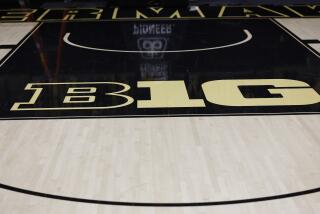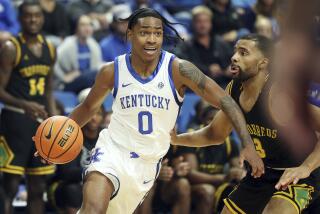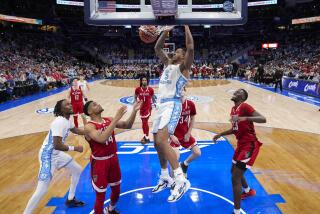NCAA Ponders Stats, Selections
INDIANAPOLIS â Itâs a basketball junkieâs dream: A comfortable chair in front of the TV, a reliable remote, round-the-clock room service and no annoying telephone calls.
What more could the 10-member NCAA tournament selection committee ask for? Well, how about some assurance they wonât be second-guessed after they announce the Division I pairings Sunday night?
That, of course, wonât happen. It never does.
What will happen, as usual, is the selection of 35 at-large teams, the seeding of those teams and the 29 automatic conference qualifiers and the placement of all 64 in the four regional brackets.
The only difference this year is the selections will be made from a hotel room in Indianapolis--where the NCAA moved its headquarters last summer--instead of Kansas City, where it set up its Selection Sunday deliberations the previous 18 years.
âEvery committee member takes this so seriously, and you want to make it right,â said Judy Rose, athletic director at North Carolina-Charlotte, one of four new members of the selection committee and the first woman to help pick the teams that will compete for the national title.
âI have watched more basketball games either in person or on television this year than I have ever probably watched in my life,â Rose said with a laugh. âI have joked with some folks and said, âYou know, Iâm turning into a man. Iâve got that remote control and Iâm going from channel to channel.ââ
The committee convened Thursday at the Westin Hotel, barely beyond 3-point range from the RCA Dome, where the Final Four will be played April 1-3.
Like sequestered jurors, the committee members were isolated from all distractions. No one could even call them without a special phone code.
âThey did tell us to bring comfortable clothes because weâre in there for the long haul,â Rose said.
The other new committee members are athletic directors Les Robinson of North Carolina State, Jim Livengood of Arizona and Gene Smith of Iowa State. All four rookies, along with a few of the returning committee members, participated in a mock selection last month to familiarize themselves with the process.
âProbably the only pressure it puts on me is the pressure I put on myself, and I donât think thatâs any different than any other committee I serve on or task that I take. And itâs not because Iâm a woman,â Rose said. âItâs because if Iâm elected to do something or agree to do something, I want to do the very best job I can do, and I donât think that has anything to do with gender.â
What got her selected to the committee was her basketball background.
Rose played at Winthrop College, was an assistant coach at Tennessee and then became the first womenâs coach at UNC-Charlotte. After eight years as coach, she became the schoolâs athletic director in 1990 and was host to a number of NCAA tournaments, including the menâs Final Four in 1994 and the womenâs Final Four in 1996. The past four years, she served as an at-large NCAA representative on the board of USA Basketball.
âWe know thereâs no way we can realistically look at 317 teams across the country throughout the year, so we are assigned conferences that we are to be more expert on than the others,â Rose said. âThe rookies were given three conferences, and the returning members were given four.â
Rose was assigned the ACC, the Southern and the Patriot conferences.
âI canât tell you the amount of paper you get to try to stay on top of it. Weâre on everybodyâs fax list. And I do look at every one of them,â she said.
The committeeâs first task was on Thursday afternoon, selecting the 96 officials that will work the tournament. Picking the teams--many of which already had been determined through conference tournaments--was to begin on Friday, and committee members had until Friday night to submit two ballots, one listing 17 schools they felt should be in the tournament and the second listing all others they felt should at least be considered.
As the choices are made, the names are put on a series of 2-foot-by-4-foot boards in the meeting room.
âOnce you get on the board, and if you get on the board on the first ballot, youâre probably going to be in the tournament,â said Craig Thompson, commissioner of the Mountain West Conference and chairman of the selection committee.
Thompson, whose own conference champion does not get an automatic bid, said the committee considers many factors in determining the at-large bids, including the Sagarin and RPI ratings, a teamâs record against the top 20, the top 50, its road record, its opponentsâ records, its record in the past 10 games--even injuries and suspensions that could affect a teamâs performance.
âThe âgoodâ wins (against strong teams) certainly are the most important things you can have,â he said of teams on the bubble. âBad losses could affect various teams, but it comes down to who youâve played and who youâve beaten.â
The automatic qualifiers didnât have to worry about that. Last year, for example, the No. 64 seed was Florida A&M;, which got in with a 12-18 record because it won the Mid-Eastern Athletic Conference tournament. The Rattlers promptly lost their first-round game 99-58 to top-seeded Duke, the eventual NCAA runner-up to Connecticut.
Connecticut was seeded second overall last year and No. 1 in the West. The other regional top seeded teams were Michigan State in the Midwest and Auburn in the South.
âIt appears the prevailing theme is this may be one of the most wide-open tournaments in the recent past. There is a lot of parity. It just makes for a tremendous tournament,â Thompson said. âA lot of people are playing really good schedules and playing each other.â
The brackets and seedings will be announced today on CBS at 3:30 p.m.
âThereâs a lot of anxiety from a commissionerâs perspective, as well as the institutions,â Thompson said. âThe whole intercollegiate basketball world is tuned in, because thatâs the first time itâs released.â
The first and second rounds will be on March 16 and 18 at Cleveland and Minneapolis (Midwest) and Salt Lake City and Tucson, Ariz. (West), and on March 17 and 19 at Buffalo, N.Y., and Winston-Salem, N.C. (East) and Nashville, Tenn., and Birmingham, Ala. (South).
The Regional tournaments will be March 23 and 25 at Auburn Hills, Mich. (Midwest), and Albuquerque, N.M. (West), and March 24 and 26 at Syracuse, N.Y. (East) and Austin, Texas (South).
More to Read
Go beyond the scoreboard
Get the latest on L.A.'s teams in the daily Sports Report newsletter.
You may occasionally receive promotional content from the Los Angeles Times.










